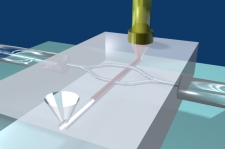Apr 19 2010
A process to integrate optical sensors on to the labs-on-chips structure directly was demonstrated by a European research project team.
 Lab-on-chip
Lab-on-chip
This achievement could render it possible to develop on-the-spot medical gadgets.
For more than 10 years researchers have focused on the concept related to the lab-on-a-chip. This concept depends on microfluidics having small sample fluid volumes traveling in microscopic channels that cut in to a range of substances like plastic, glass, and silicon. This technology has developed significantly and now scientists are able to separate molecular level samples on a postage stamp sized chip.
However, this lab-on-chip cannot address a major problem that forces scientists to use large-scale equipment for detecting and identifying the molecules that flow in the microfluidic chips. The fluidics is at the microscale level but it requires the large-sized laboratories’ macrodomain for optical molecular detection. To tackle this issue, a project funded by the EU inscribed features in microfluidic chips to render the possibility of integrated optical detection.
The femtosecond laser micromachining technique was adopted by the HIBISCUS consortium of industrial and academic partners. The femtosecond laser transmits very short flashes of light, with each flash having duration as low as few millionths of a billionth of one second. The laser pulses results in very intense laser beam and is able to transform materials in unusual means. The laser pulse is used as a pen or a microscopic tool for focusing the laser beam for drawing actual three-dimensional features on a thin glass wafer.
This technique has been utilized for cutting delicate components already, such as motors and gears in silicon. The team used the technique to inscribe waveguide form of tracks in labs-on-chips. These waveguides could guide light through the chip over the microfluidic channels and also out from the chip where it was detected. The lasers could be utilized to make the microfluidic channels also.
Currently a light source, mostly a laser, can be made to shine in the fluid sample for detecting optical activity in the chip or the absorption of the fluid, instead of taking a sample from a chip and analyzing it by using lab equipment.
Large-sized labs-on-chips prototypes have been developed by the project by utilizing integrated waveguides for various applications like an assay for separation and fragmentation of a DNA fragment, as well as a chemical micro-reactor for use in protein synthesis. The assay can also be utilized for detecting particular disease markers that are present in patient samples.
There are three commercial SME partners in the consortium. These partners are leveraging the benefits of the project’s results. The femtosecond laser that was developed during the project is currently being sold by the Austria-based High Q Laser. The microfluidic chips are now being made by the Netherlands-based Lionex who is also planning to manufacture labs-on-chips with waveguides incorporated. Zebra Bioscience, a Dutch firm, is producing point-of-care diagnostics kits.
The integrated optical detection renders the concept of utilizing microfluidics for pharmaceutical products feasible as a more eco-friendly and efficient manufacturing process.